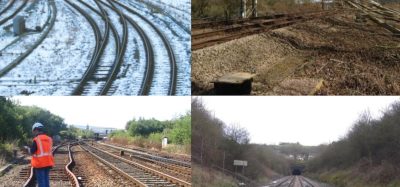The communication and signalling network of ÖBB
Posted: 28 July 2006 | | No comments yet
At the beginning of the 1990s, and due to the occurrence of some heavy accidents, ÖBB began to look for a new train protection system to fit the requirements of an increased traffic capacity on the lines and as a result of this, the necessity to increase safety on the whole network of ÖBB. Subsequently, ÖBB started evaluating different products existing on the market.
At the beginning of the 1990s, and due to the occurrence of some heavy accidents, ÖBB began to look for a new train protection system to fit the requirements of an increased traffic capacity on the lines and as a result of this, the necessity to increase safety on the whole network of ÖBB. Subsequently, ÖBB started evaluating different products existing on the market.
At the beginning of the 1990s, and due to the occurrence of some heavy accidents, ÖBB began to look for a new train protection system to fit the requirements of an increased traffic capacity on the lines and as a result of this, the necessity to increase safety on the whole network of ÖBB. Subsequently, ÖBB started evaluating different products existing on the market.
At this time, the system development of ERTMS/ETCS had started but no products where available. As a future member of the European Union, Austria was invited and forced by the Commission to participate in the development process of ERTMS/ETCS.
The Hungarian State Railways, MÁV Co, and ÖBB – as possible future users of the new system – together with the industry partners Alcatel Austria, Ansaldo, Alstom, CSEE Transport and ARSENAL research, as an independent body, first started operational trials of an ETCS Level 1 system in Europe in 1999 on a section of the Vienna-Budapest line covering sections in Hungary and Austria. The successful finalisation of those operational tests consequently lead to a project to install ETCS Level 1 on the complete Vienna-Budapest line. The Austrian part of the project for the 67km line section from Vienna to the Hungarian boarder station Hegyeshalom started in 2001 and the implementation was finished in 2005. The ETCS system is interfaced with three different kinds of interlocking (two type relay-interlocking and one type electronic interlocking), within the project the ETCS system has been installed on 13 double traction locomotives of the type 1116 (Taurus).
Situation
The existing high-speed line on the Austrian network is equipped with the ATP/ATC system LZB since 1992. The rest of the network is covered by the ATP system INDUSI/PZB which is a system with high reliability but is a non fail safe system.
Meanwhile, the main lines and the Austrian core net has a high denseness on modern interlocking (with conventional lineside signalling), especially electronic interlocking and therefore a new signalling infrastructure.
The maximum permitted speed on all lines is 160km/h except for the HS line with maximum speed of 200km/h.
The operational situation is that on all lines described above, even on the HS line, mixed traffic is the reality. So, a control command system has to cover requirements from freight traffic up to HS passenger traffic.
The main lines and the core net of the whole Austrian rail network are part of TEN corridors and therefore the directives 96/48 and 2001/16, with their TSI on Control Command and Signalling, are valid for those lines.
Following the need to increase safety and the requirements of the directives for the TEN net, the ÖBB board decided in 2001 to implement ERTMS/ETCS on its core network. Based on this decision, a strategy for further implementation of ETCS and the kind of application level have been elaborated. The basic parameters for the decision of which ETCS application level will be implemented are; increase of safety on lines with high traffic density, no decrease of capacity, good economical ratio, interfaces to the existing signalling system as simple as possible and no repercussion on the design of those interlocking and achieving interoperability on TEN corridors running through Austria.
The experiences collected on the Vienna-Budapest ETCS Level 1 trial line and the implementation project of ETCS Level 1 on the line from Vienna to the Hungarian boarder, prove that ETCS Level 1 with infill functionality is able to increase safety, compared to ETCS Level 2 where the costs are a clear-cut lower, the interfaces to the existing signalling systems are simple and independent from the type of interlocking.
Concerning the capacity of ETCS offers big advantages using cab-signalling onboard and providing explicit route information from lineside equipment. ETCS offers the possibility to decelerate the train later and accelerate earlier than with conventional lineside signalling and the corresponding operational rules, and as a consequence, providing the possibility for higher capacity.
In contradiction to that capacity increasing feature is the possible decrease of capacity when implementing ETCS (independent of the level of application). There is a constraint between the configuration of stations and the safety requirement of ETCS. In particular, when the distance between the target signal and the following danger point (ETCS term supervised location SvL) is short (e.g. < 20m). In that case, as a result of the system safety requirements, the onboard ETCS-unit will bring the train to a standstill approximately 50-150m in front of the target signal, depending on the braking characteristic of the train.
To achieve interoperability on a corridor running through Austria and increase safety on a high density line, the line from Salzburg to Vienna with the branch Wels-Passau is selected as the next step of implementation. For that project, three competitors laid their offers and the contract with the winner was signed in December 2005. The implementation is foreseen to be ready in 2008, by which time an important west-east TEN Corridor through Austria from the German to the Hungarian boarder will be equipped with ETCS.
Outlook
The next important steps are two HS lines which are planned to begin operations in 2012 – the HS line Wörgl-Innsbruck on the corridor München-Verona, and the new HS line between Wien and St. Pölten (part of the west main line).
For these two lines, the decision has been taken to implement ETCS Level 2. The planning phase for ETCS implementation on those two lines commenced at the beginning of this year. During that phase, some challenges could be detected; there are on both lines junctions with conventional lines approximately every 20km with interlockings controlling the HS and the CR line with the operational requirement to exchange the traffic between HS and CR and vice versa without any operational restrictions.
In parallel to the ETCS L2 activities on the HS lines, the implementation of ETCS Level 1 on the core net will be continued after finalisation of the Wien-Salzburg, Wels-Passau project. The following stages will be the lines Wien-Graz (Südbahn), Salzburg-Schwarzach-Wörgl (with the connection to the L2 HS line in Wörgl), Innsbruck-Bregenz and Innsbruck-Brennero.
Completion date is expected to be 2012. The rest of the core net shall be finished in the time frame 2015 – 2020.
GSM-R at ÖBB
Austrian Federal Railways are planning the introduction of GSM-R primary as a substitution of the analogue track to train UIC 751-3 radio system, which has been in operation since the early 70s.
Plans to implement shunting radio with GSM-R are also suggested. The channel capacity needed for the shunting radio system in the shunting yards (so called ‘Hot Spots’) will be done by special Base Transceiver Stations (BTS). All other radio systems in the frequency range between 80 MHz and 460 MHz will be changed to GSM-R according to the growth of the GSM-R network.
Pilot project
The ÖBB started the call for tender in April and results are expected in September 2006. This leads to phase 0 – the pilot phase. The railway line Wels-Passau will be equipped with the new system. Existing infrastructure, like fixed net telephone systems and the trackside telephone systems, are not the same in every country and interoperability with GSM-R has to therefore be tested and probably parameterised during integration.
The pilot line meets Germany in Passau and Roaming and Hand Over tests with the network of DB will be tested. The precise point between the German and the Austrian network has to be defined and tested by DB and ÖBB specialists – it can be the border between the two countries or when required the radio coverage of the Austrian GSM-R network can be extended as far as Passau Hbf.
The Main goal of the pilot projects are operational tests of the system in real operation of the track to train functions and the shunting radio functions while the analogue systems still work in parallel.
Since January 2005, Austrian locomotives have been equipped with so called dual mode radios, and for traffic to Germany, 650 of such radios are foreseen. All other engines will be equipped according to the roll out of the GSM-R network.
Implementation of Shunting Radio
The realisation of shunting radio on the basis of GSM-R requires a special concept of coverage. On the one hand, the field strength in a shunting yard has to be high because of the need for radio coverage between the wagons; on the other hand up to 17 shunting groups must have the possibility to set up a group call all at once. In big cities the stations are very close together so that troubles and faults cannot be excluded.
ÖBB will therefore implement a special cell structure in shunting yards. One BTS will cover the shunting region with repeaters with lower power. This minimises the need of frequencies and can be repeated in closer distances.
Radio Coverage
The layout of Austrian GSM-R network is planned in such a way that, if needed, in future (ETCS Level 2) the number of sites (BTS) can be doubled. It will be proved later if such a double radio coverage (Double overlapping) makes sense in a technical and economic way.
The most frequent fault is the damage of the cable; therefore, all BTS are connected from two sides (rings).
All other components of the GSM-R system are implemented redundant. A dead loss of the network for a longer time is therefore most improbable. Real dates of availability will show if the double coverage is really necessary.
More over, Austria is a very hilly country. On mountainous lines (such as Semmering, Tauern, Arlberg etc.) many base stations in the future would be needed. This fact could cause problems with Hand Over, similar to high speed lines. In this case, ÖBB also uses the repeater technique like in shunting yards. The coverage of one cell will be extended and the overlapping between two cells is well defined. Because of the lower radiation, power frequencies can be repeated in closer distances (smaller disturbance range).
Functionalities of the Austrian GSM-R networks
The introduction of GSM-R is primarily thought of as a substitution of the analogue track to train UIC 751-3 radio system. Via Intelligent Network (IN) a connection to RZÜ (a special computer controlled system of ÖBB for train supervision) will be made for additional locations depending addressing.
The modularity of GSM allows the later implementation of features like VMS, SMS or GPRS without loss of effort. The implementation of these additional functionalities depends on the needs of users.
To minimise capacity, introducing overflow features a near contact between users and a special telecom department which is responsible for GSM-R implementation at ÖBB is necessary. Perhaps the network capacity has to be adopted.
Migration of GSM-R system at ÖBB
ÖBB will run the old analogue UIC system in parallel with GSM-R until all main lines (approximately 3,500km) are equipped with GSM-R. The engines will have dual mode radio sets so that there is no difference for the dispatcher if there is a call from the analogue or the digital system. A special dispatcher telephone system for train controllers will make this possible.
After the testing phase along the line Wels-Passau, all other main lines of Austrian Railways will be equipped with GSM-R. That will start in 2007 with the Westbahn between Wien and Bregenz and the Brenner and Tauern corridor followed by the Südbahn between Wien and Villach. Until 2012, all main lines and some secondary lines will be equipped with GSM-R – perhaps some lines of low importance will use the public GSM network.
Global Railway Review Autumn/ Winter Issue 2025
Welcome to 2025’s Autumn/ Winter issue of Global Railway Review!
The dynamism of our sector has never been more apparent, driven by technological leaps, evolving societal demands, and an urgent global imperative for sustainable solutions.
>>> Read the issue in full now! <<<
Issue
Related topics
European Rail Traffic Management System (ERTMS), European Train Control System (ETCS), Global System for Mobile Communications – Railway (GSM-R), Signalling, Control & Communications







